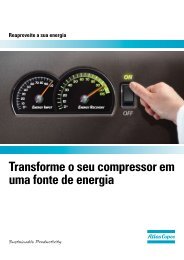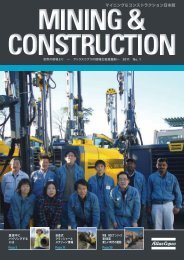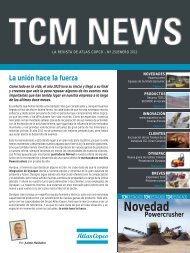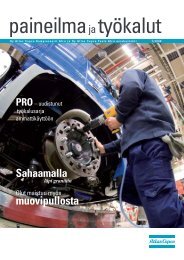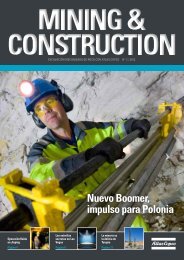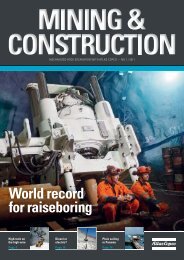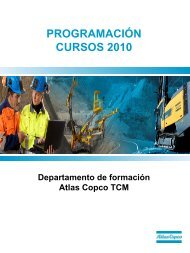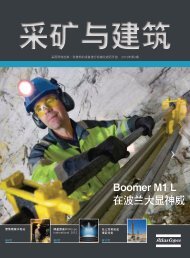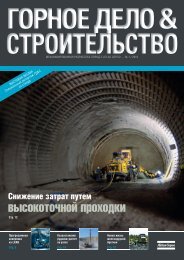Exploration drilling Serbian style - Atlas Copco
Exploration drilling Serbian style - Atlas Copco
Exploration drilling Serbian style - Atlas Copco
You also want an ePaper? Increase the reach of your titles
YUMPU automatically turns print PDFs into web optimized ePapers that Google loves.
Uphole Velocities<br />
Compressor<br />
At Sea Level/15° C (59° F) At 15 000 ft/ –14° C (7° F)<br />
1 900 cfm = 53.8 m 3 /min<br />
1 000 ft = 304 m<br />
5 000 ft/min = 25.4 m/s<br />
Hole<br />
Ø (in)<br />
Drill Rod<br />
Ø (in)<br />
Rating: 1 900 cfm Rating: 2 600 cfm Rating: 1 900 cfm Rating 2 600 cfm<br />
Effective Vol. 1 900 cfm Effective Vol. 2 600 cfm Effective Vol. 1 221 cfm Effective Vol. 1 670 cfm<br />
10 ⁵⁄₈ 7 5⁄8 6 434 ft/min (A) 8 804 ft/min 4 087 ft/min 5 592 ft/min (B)<br />
10 ⁵⁄₈ 8 ⁵⁄₈ 9 149 ft/min 12 520 ft/min 5 812 ft/min (C) 7 953 ft/min<br />
9 ⁷⁄₈ 7 5⁄8 8 946 ft/min 12 242 ft/min 5 682 ft/min 7 776 ft/min<br />
9 ⁷⁄₈ 8 ⁵⁄₈ 15 232 ft/min 20 855 ft/min 9 675 ft/min 13 240 ft/min<br />
Fig 2. Comparison of compressor performance at high altitude vs sea level and subsequent<br />
effect on uphole velocity in rotary <strong>drilling</strong> using a Pit Viper 271 drill rig.<br />
At 15 000 feet (4 572 m), the same compressor<br />
is still taking in 1 900 cubic feet<br />
of air per minute. However, the number<br />
of molecules of air is reduced by approximately<br />
42%, calculated by comparing the<br />
air pressure at sea level (101 kPa,14.7 psi)<br />
to the pressure at elevation (59 kPa, 8.6 psi).<br />
To compensate for the lower density,<br />
correction factors are used to calculate the<br />
effective, not actual, intake cfm required<br />
to produce the same performance as at sea<br />
level. In this case, the reduced air pressure<br />
effectively cuts the compressor to an equivalent<br />
intake capacity of 1 106 cfm (assuming<br />
the same temperature as at sea level).<br />
Taking into account the lower temperature<br />
and corresponding increase in density, the<br />
intake capacity would move up to 1 221 cfm<br />
at 7°F (–14°C).<br />
Uphole velocity<br />
To determine how much air is required, a<br />
calculation of uphole velocity needs to be<br />
made. Uphole velocity is calculated from<br />
the intake air volume and the annular area,<br />
which is the gap between the wall of the<br />
hole and the drill rod. A minimum uphole<br />
velocity is often stated as 5 000 ft/min but<br />
in reality is affected by the density, size and<br />
shape of the chips, and factors such as the<br />
pressure of chips or water in the hole and<br />
the condition of the borehole wall.<br />
Using a Pit Viper 271 as an example, the<br />
table above (Fig 2) shows a comparison.<br />
At sea level, 1 900 cfm for a 10⅝" bit with<br />
a 7⅝"rod works well (A), even as the rod<br />
wears down. At high altitude, the large<br />
reduction in air density requires either<br />
a larger compressor (B) (2 600 cfm) or a<br />
larger (8⅝") diameter drill rod (C).<br />
The preferred option is a larger compressor,<br />
as using larger rods cuts the clearance<br />
between the wall of the hole and the rod to<br />
such a small gap that larger cuttings must be<br />
reground to a smaller size before exiting the<br />
hole, thus accelerating bit wear. Going to a<br />
smaller diameter bit will improve uphole<br />
velocity as well, though this is not always<br />
feasible given the blasting requirements.<br />
Power drain<br />
Diesel engines face considerable difficulty<br />
at high altitude as they rely on the oxygen in<br />
the air for proper combustion. Engines have<br />
varying altitude limits and power de-rate<br />
curves. Manufacturers are able to maintain<br />
full power to the altitude rating by changing<br />
the engine timing, turbocharger configuration<br />
and compression ratios. Above this altitude<br />
rating horsepower begins to decrease.<br />
As a rule of thumb a diesel engine will<br />
de-rate its output by 3% per 1 000 ft above<br />
altitude limit. For example, an 800 hp diesel<br />
engine might have an altitude limit of<br />
8 000 ft. At 15 000 ft the power would be<br />
21% less, or 632 hp. However, because the<br />
air compressor is working with lower density<br />
air, its power requirement is reduced by<br />
1.5% per 1 000 ft. The 1 900 cfm compressor<br />
itself requires approximately 430 hp to<br />
provide full flow and pressure. At 15 000 ft,<br />
the load drops by 22.5% to 333 hp, effectively<br />
cutting the total load from 720 hp to<br />
623 hp, safely below the de-rated power.<br />
For best results, it is preferable to go with<br />
a larger displacement engine with a higher<br />
output to offset the reduction in power due<br />
to altitude. However, it is not always possible<br />
to provide larger engines as the drills<br />
are designed to handle a particular size<br />
engine from the beginning and space is not<br />
available.<br />
Another alternative is electric power.<br />
Electric motors do not rely on combustion<br />
for power and are not subject to power loss<br />
due to lack of oxygen. The only impact on<br />
motors is the decreased cooling capacity at<br />
altitude.<br />
The decision to go with electric power<br />
has to take other factors into consideration<br />
such as how electricity is generated and the<br />
demand for mobility of the rig. In such a<br />
case, a diesel powered rig can still be the<br />
best alternative if it can be configured to<br />
meet the required performance. Electric<br />
power may offer higher capacity but this<br />
might be offset by the mobility and higher<br />
utilization of a diesel powered rig.<br />
Human impact<br />
Aside from the engine, compressor and<br />
cooling systems, there is little impact on the<br />
drill simply from the altitude. The biggest<br />
impact is on the operators and technicians<br />
working on the drills. The human body<br />
compensates for the decreased amount of<br />
oxygen with higher respiratory and heart<br />
rates along with a gradual increase in red<br />
blood cells that carry oxygen (known as<br />
acclimatization).<br />
Mining companies are very careful when<br />
it comes to ensuring the safety of their<br />
employees and contractors. Examination by<br />
medical experts is required before allowing<br />
work in these tough conditions, and full<br />
onsite medical services are available to deal<br />
with problems. Ultimately, autonomous<br />
<strong>drilling</strong> will play a significant role as mining<br />
companies push to higher elevations.<br />
Brian Fox is Vice President<br />
Marketing at <strong>Atlas</strong> <strong>Copco</strong><br />
Drilling Solutions. He is<br />
a member of the team<br />
behind the development of<br />
the Pit Viper drill rig series<br />
in Garland, Texas.<br />
Mining & Construction – 1 / 2012 11



